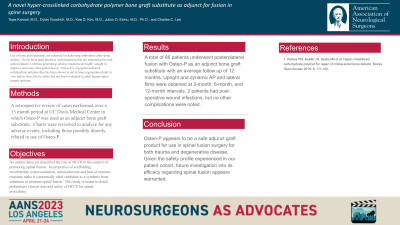A Novel Hyper-Crosslinked Carbohydrate Polymer Bone Graft Substitute as Adjunct for Fusion in Spine Surgery
A Novel Hyper-crosslinked Carbohydrate Polymer Bone Graft Substitute as Adjunct for Fusion in Spine Surgery
Friday, April 21, 2023

- TK
Tejas Karnati, MD (he/him/his)
Chief Resident
UC Davis Medical Center
Sacramento, California, United States
ePoster Presenter(s)
Introduction: Use of bone graft materials are essential for achieving arthrodesis after spine surgery. Safe bone graft products with both osteoinductive and osteoconductive properties and ability to monitor fusion real time are very desirable. Osteo-P Bone Graft Substitute (BGS) is a novel hypercrosslinked carbohydrate polymer that has been shown to aid in bone regeneration both in vitro and in vivo preclinical studies, but its safety has not been evaluated in humans. This study was conducted to evaluate its clinical application and safety in adult human spine surgery patients.
Methods: A retrospective review of cases performed from April 2019 to April, 2020 at UC Davis Medical Center in which Osteo-P BGS was used as an adjunct bone graft substitute was conducted. Charts were reviewed to analyze for any adverse events, including those possibly related to use of Osteo-P BGS.
Results: A total of 80 patients underwent postero-lateral fusion with Osteo-P BGS as an adjunct bone graft substitute with an average follow up of 8 months. No adverse reaction related to Osteo-P BGS were identified. Fusion success was noted to be non-inferior to other bone graft substitutes.
Conclusion : Osteo-P BGS appears to be a safe adjunct graft product for use in spinal fusion surgery for both trauma and degenerative disease. It has a good degradation profile for forming bone with ability to provide new vasculature to the bone. It may also function as a scaffold to carry cells, medications, and growth factors. Given the safety profile experienced in our patient cohort, future investigation into its efficacy to achieve a solid fusion is currently ongoing.
Methods: A retrospective review of cases performed from April 2019 to April, 2020 at UC Davis Medical Center in which Osteo-P BGS was used as an adjunct bone graft substitute was conducted. Charts were reviewed to analyze for any adverse events, including those possibly related to use of Osteo-P BGS.
Results: A total of 80 patients underwent postero-lateral fusion with Osteo-P BGS as an adjunct bone graft substitute with an average follow up of 8 months. No adverse reaction related to Osteo-P BGS were identified. Fusion success was noted to be non-inferior to other bone graft substitutes.
Conclusion : Osteo-P BGS appears to be a safe adjunct graft product for use in spinal fusion surgery for both trauma and degenerative disease. It has a good degradation profile for forming bone with ability to provide new vasculature to the bone. It may also function as a scaffold to carry cells, medications, and growth factors. Given the safety profile experienced in our patient cohort, future investigation into its efficacy to achieve a solid fusion is currently ongoing.
